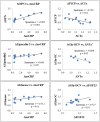Effects of short-term dry immersion on bone remodeling markers, insulin and adipokines
- PMID: 28806419
- PMCID: PMC5555617
- DOI: 10.1371/journal.pone.0182970
Effects of short-term dry immersion on bone remodeling markers, insulin and adipokines
Abstract
Background: Dry immersion (DI), a ground-based model of microgravity previously used in Russia, has been recently implemented in France. The aim of this study was to analyze early events in a short-term DI model in which all conditions are met to investigate who is first challenged from osteo- or adipo-kines and to what extent they are associated to insulin-regulating hormones.
Methods: Twelve healthy men were submitted to a 3-day DI. Fasting blood was collected during pre-immersion phase for the determination of the baseline data collection (BDC), daily during DI (DI24h, DI48H and DI72h), then after recovery (R+3h and R+24h). Markers of bone turnover, phosphocalcic metabolism, adipokines and associated factors were measured.
Results: Bone resorption as assessed by tartrate-resistant acid phosphatase isoform 5b and N-terminal crosslinked telopeptide of type I collagen levels increased as early as DI24h. At the same time, total procollagen type I N- and C-terminal propeptides and osteoprotegerin, representing bone formation markers, decreased. Total osteocalcin [OC] was unaffected, but its undercarboxylated form [Glu-OC] increased from DI24h to R+3h. The early and progressive increase in bone alkaline phosphatase activities suggested an increased mineralization. Dickkopf-1 and sclerostin, as negative regulators of the Wnt-β catenin pathway, were unaltered. No change was observed either in phosphocalcic homeostasis (calcium and phosphate serum levels, 25-hydroxyvitamin D, fibroblast growth factor 23 [FGF23]) or in inflammatory response. Adiponectemia was unchanged, whereas circulating leptin concentrations increased. Neutrophil gelatinase-associated lipocalin [lipocalin-2], a potential regulator of bone homeostasis, was found elevated by 16% at R+3h compared to DI24h. The secretory form of nicotinamide phosphoribosyl-transferase [visfatin] concentrations almost doubled after one day of DI and remained elevated. Serum insulin-like growth factor 1 levels progressively increased. Fasting insulin concentrations increased during the entire DI, whereas fasting glucose levels tended to be higher only at DI24h and then returned to BDC values. Changes in bone resorption parameters negatively correlated with changes in bone formation parameters. Percent changes of ultra-sensitive C-reactive protein positively correlated with changes in osteopontin, lipocalin-2 and fasting glucose. Furthermore, a positive correlation was found between changes in FGF23 and Glu-OC, the two main osteoblast-/osteocyte-derived hormones.
Conclusion: Our results demonstrated that DI induced an unbalanced remodeling activity and the onset of insulin resistance. This metabolic adaptation was concomitant with higher levels of Glu-OC. This finding confirms the role of bone as an endocrine organ in humans. Furthermore, visfatin for which a great responsiveness was observed could represent an early and sensitive marker of unloading in humans.
Conflict of interest statement
Figures




Similar articles
-
DI-5-Cuffs: Bone Remodelling and Associated Metabolism Markers in Humans After Five Days of Dry Immersion to Simulate Microgravity.Front Physiol. 2022 Apr 27;13:801448. doi: 10.3389/fphys.2022.801448. eCollection 2022. Front Physiol. 2022. PMID: 35574450 Free PMC article.
-
Bone turnover response is linked to both acute and established metabolic changes in ultra-marathon runners.Endocrine. 2017 Apr;56(1):196-204. doi: 10.1007/s12020-016-1012-8. Epub 2016 Jul 15. Endocrine. 2017. PMID: 27422791
-
Effects of short-term recombinant human insulin-like growth factor I administration on bone turnover in osteopenic women with anorexia nervosa.J Clin Endocrinol Metab. 1996 Nov;81(11):3864-70. doi: 10.1210/jcem.81.11.8923830. J Clin Endocrinol Metab. 1996. PMID: 8923830 Clinical Trial.
-
[Biochemical markers of bone turnover. New aspect. Bone metabolic markers available in daily practice].Clin Calcium. 2009 Aug;19(8):1075-82. Clin Calcium. 2009. PMID: 19638690 Review. Japanese.
-
Markers of bone turnover: biochemical and clinical perspectives.J Endocrinol Invest. 2005;28(10 Suppl):8-13. J Endocrinol Invest. 2005. PMID: 16550716 Review.
Cited by
-
Novel Adipokines and Their Role in Bone Metabolism: A Narrative Review.Biomedicines. 2023 Feb 20;11(2):644. doi: 10.3390/biomedicines11020644. Biomedicines. 2023. PMID: 36831180 Free PMC article. Review.
-
Association of serum levels of Visfatin, Intelectin-1, RARRES2 and their genetic variants with bone mineral density in postmenopausal females.Front Endocrinol (Lausanne). 2022 Nov 30;13:1024860. doi: 10.3389/fendo.2022.1024860. eCollection 2022. Front Endocrinol (Lausanne). 2022. PMID: 36531488 Free PMC article.
-
Dissociation of Bone Resorption and Formation in Spaceflight and Simulated Microgravity: Potential Role of Myokines and Osteokines?Biomedicines. 2022 Feb 1;10(2):342. doi: 10.3390/biomedicines10020342. Biomedicines. 2022. PMID: 35203551 Free PMC article. Review.
-
A dry immersion model of microgravity modulates platelet phenotype, miRNA signature, and circulating plasma protein biomarker profile.Sci Rep. 2021 Nov 9;11(1):21906. doi: 10.1038/s41598-021-01335-x. Sci Rep. 2021. PMID: 34753989 Free PMC article.
-
The Skeletal Cellular and Molecular Underpinning of the Murine Hindlimb Unloading Model.Front Physiol. 2021 Oct 19;12:749464. doi: 10.3389/fphys.2021.749464. eCollection 2021. Front Physiol. 2021. PMID: 34737712 Free PMC article. Review.
References
-
- Nagaraja MP, Risin D. The current state of bone loss research: data from spaceflight and microgravity simulators. J Cell Biochem. 2013;114: 1001–1008. doi: 10.1002/jcb.24454 - DOI - PubMed
-
- Hargens AR, Vico L. Long-duration bed rest as an analog to microgravity. J Appl Physiol Bethesda Md 1985. 2016;120: 891–903. doi: 10.1152/japplphysiol.00935.2015 - DOI - PubMed
-
- Heer M, Baecker N, Mika C, Boese A, Gerzer R. Immobilization induces a very rapid increase in osteoclast activity. Acta Astronaut. 2005;57: 31–36. - PubMed
-
- Baecker N, Tomic A, Mika C, Gotzmann A, Platen P, Gerzer R, et al. Bone resorption is induced on the second day of bed rest: results of a controlled crossover trial. J Appl Physiol Bethesda Md 1985. 2003;95: 977–982. doi: 10.1152/japplphysiol.00264.2003 - DOI - PubMed
-
- Morgan JLL, Zwart SR, Heer M, Ploutz-Snyder R, Ericson K, Smith SM. Bone metabolism and nutritional status during 30-day head-down-tilt bed rest. J Appl Physiol Bethesda Md 1985. 2012;113: 1519–1529. doi: 10.1152/japplphysiol.01064.2012 - DOI - PMC - PubMed
Publication types
MeSH terms
Substances
LinkOut - more resources
Full Text Sources
Other Literature Sources
Medical
Research Materials
Miscellaneous

